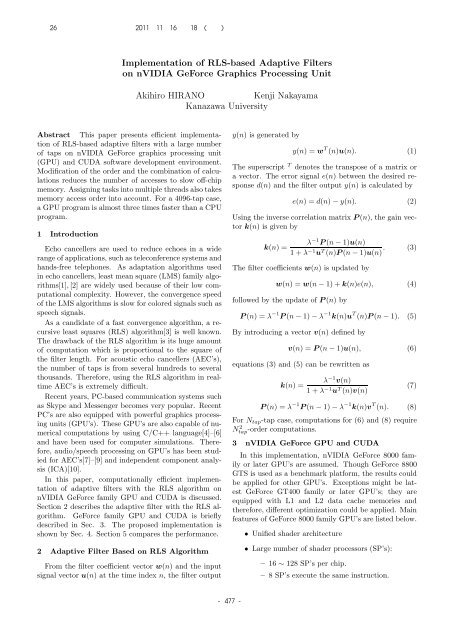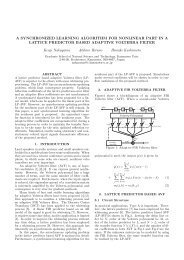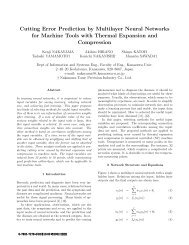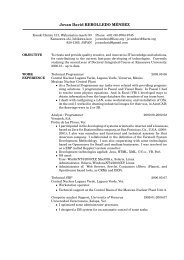Implementation of RLS-based Adaptive Filters on nVIDIA GeForce ...
Implementation of RLS-based Adaptive Filters on nVIDIA GeForce ...
Implementation of RLS-based Adaptive Filters on nVIDIA GeForce ...
You also want an ePaper? Increase the reach of your titles
YUMPU automatically turns print PDFs into web optimized ePapers that Google loves.
<str<strong>on</strong>g>Implementati<strong>on</strong></str<strong>on</strong>g> <str<strong>on</strong>g>of</str<strong>on</strong>g> <str<strong>on</strong>g>RLS</str<strong>on</strong>g>-<str<strong>on</strong>g>based</str<strong>on</strong>g> <str<strong>on</strong>g>Adaptive</str<strong>on</strong>g> <str<strong>on</strong>g>Filters</str<strong>on</strong>g><br />
<strong>on</strong> <strong>nVIDIA</strong> <strong>GeForce</strong> Graphics Processing Unit<br />
Akihiro HIRANO Kenji Nakayama<br />
Kanazawa University<br />
Abstract This paper presents efficient implementati<strong>on</strong><br />
<str<strong>on</strong>g>of</str<strong>on</strong>g> <str<strong>on</strong>g>RLS</str<strong>on</strong>g>-<str<strong>on</strong>g>based</str<strong>on</strong>g> adaptive filters with a large number<br />
<str<strong>on</strong>g>of</str<strong>on</strong>g> taps <strong>on</strong> <strong>nVIDIA</strong> <strong>GeForce</strong> graphics processing unit<br />
(GPU) and CUDA s<str<strong>on</strong>g>of</str<strong>on</strong>g>tware development envir<strong>on</strong>ment.<br />
Modificati<strong>on</strong> <str<strong>on</strong>g>of</str<strong>on</strong>g> the order and the combinati<strong>on</strong> <str<strong>on</strong>g>of</str<strong>on</strong>g> calculati<strong>on</strong>s<br />
reduces the number <str<strong>on</strong>g>of</str<strong>on</strong>g> accesses to slow <str<strong>on</strong>g>of</str<strong>on</strong>g>f-chip<br />
memory. Assigning tasks into multiple threads also takes<br />
memory access order into account. For a 4096-tap case,<br />
a GPU program is almost three times faster than a CPU<br />
program.<br />
1 Introducti<strong>on</strong><br />
Echo cancellers are used to reduce echoes in a wide<br />
range <str<strong>on</strong>g>of</str<strong>on</strong>g> applicati<strong>on</strong>s, such as telec<strong>on</strong>ference systems and<br />
hands-free teleph<strong>on</strong>es. As adaptati<strong>on</strong> algorithms used<br />
in echo cancellers, least mean square (LMS) family algorithms[1],<br />
[2] are widely used because <str<strong>on</strong>g>of</str<strong>on</strong>g> their low computati<strong>on</strong>al<br />
complexity. However, the c<strong>on</strong>vergence speed<br />
<str<strong>on</strong>g>of</str<strong>on</strong>g> the LMS algorithms is slow for colored signals such as<br />
speech signals.<br />
As a candidate <str<strong>on</strong>g>of</str<strong>on</strong>g> a fast c<strong>on</strong>vergence algorithm, a recursive<br />
least squares (<str<strong>on</strong>g>RLS</str<strong>on</strong>g>) algorithm[3] is well known.<br />
The drawback <str<strong>on</strong>g>of</str<strong>on</strong>g> the <str<strong>on</strong>g>RLS</str<strong>on</strong>g> algorithm is its huge amount<br />
<str<strong>on</strong>g>of</str<strong>on</strong>g> computati<strong>on</strong> which is proporti<strong>on</strong>al to the square <str<strong>on</strong>g>of</str<strong>on</strong>g><br />
the filter length. For acoustic echo cancellers (AEC’s),<br />
the number <str<strong>on</strong>g>of</str<strong>on</strong>g> taps is from several hundreds to several<br />
thousands. Therefore, using the <str<strong>on</strong>g>RLS</str<strong>on</strong>g> algorithm in realtime<br />
AEC’s is extremely difficult.<br />
Recent years, PC-<str<strong>on</strong>g>based</str<strong>on</strong>g> communicati<strong>on</strong> systems such<br />
as Skype and Messenger becomes very popular. Recent<br />
PC’s are also equipped with powerful graphics processing<br />
units (GPU’s). These GPU’s are also capable <str<strong>on</strong>g>of</str<strong>on</strong>g> numerical<br />
computati<strong>on</strong>s by using C/C++ language[4]–[6]<br />
and have been used for computer simulati<strong>on</strong>s. Therefore,<br />
audio/speech processing <strong>on</strong> GPU’s has been studied<br />
for AEC’s[7]–[9] and independent comp<strong>on</strong>ent analysis<br />
(ICA)[10].<br />
In this paper, computati<strong>on</strong>ally efficient implementati<strong>on</strong><br />
<str<strong>on</strong>g>of</str<strong>on</strong>g> adaptive filters with the <str<strong>on</strong>g>RLS</str<strong>on</strong>g> algorithm <strong>on</strong><br />
<strong>nVIDIA</strong> <strong>GeForce</strong> family GPU and CUDA is discussed.<br />
Secti<strong>on</strong> 2 describes the adaptive filter with the <str<strong>on</strong>g>RLS</str<strong>on</strong>g> algorithm.<br />
<strong>GeForce</strong> family GPU and CUDA is briefly<br />
described in Sec. 3. The proposed implementati<strong>on</strong> is<br />
shown by Sec. 4. Secti<strong>on</strong> 5 compares the performance.<br />
2 <str<strong>on</strong>g>Adaptive</str<strong>on</strong>g> Filter Based <strong>on</strong> <str<strong>on</strong>g>RLS</str<strong>on</strong>g> Algorithm<br />
From the filter coefficient vector w(n) and the input<br />
signal vector u(n) at the time index n, the filter output<br />
y(n) is generated by<br />
y(n) = w T (n)u(n). (1)<br />
The superscript T denotes the transpose <str<strong>on</strong>g>of</str<strong>on</strong>g> a matrix or<br />
a vector. The error signal e(n) between the desired resp<strong>on</strong>se<br />
d(n) and the filter output y(n) is calculated by<br />
e(n) = d(n) − y(n). (2)<br />
Using the inverse correlati<strong>on</strong> matrix P(n), the gain vector<br />
k(n) is given by<br />
k(n) =<br />
λ −1 P(n − 1)u(n)<br />
1 + λ −1 u T (n)P (n − 1)u(n) . (3)<br />
The filter coefficients w(n) is updated by<br />
w(n) = w(n − 1) + k(n)e(n), (4)<br />
followed by the update <str<strong>on</strong>g>of</str<strong>on</strong>g> P (n) by<br />
P (n) = λ −1 P (n − 1) − λ −1 k(n)u T (n)P (n − 1). (5)<br />
By introducing a vector v(n) defined by<br />
v(n) = P(n − 1)u(n), (6)<br />
equati<strong>on</strong>s (3) and (5) can be rewritten as<br />
k(n) =<br />
λ −1 v(n)<br />
1 + λ −1 u T (n)v(n)<br />
(7)<br />
P(n) = λ −1 P(n − 1) − λ −1 k(n)v T (n). (8)<br />
For N tap -tap case, computati<strong>on</strong>s for (6) and (8) require<br />
Ntap 2 -order computati<strong>on</strong>s.<br />
3 <strong>nVIDIA</strong> <strong>GeForce</strong> GPU and CUDA<br />
In this implementati<strong>on</strong>, <strong>nVIDIA</strong> <strong>GeForce</strong> 8000 family<br />
or later GPU’s are assumed. Though <strong>GeForce</strong> 8800<br />
GTS is used as a benchmark platform, the results could<br />
be applied for other GPU’s. Excepti<strong>on</strong>s might be latest<br />
<strong>GeForce</strong> GT400 family or later GPU’s; they are<br />
equipped with L1 and L2 data cache memories and<br />
therefore, different optimizati<strong>on</strong> could be applied. Main<br />
features <str<strong>on</strong>g>of</str<strong>on</strong>g> <strong>GeForce</strong> 8000 family GPU’s are listed below.<br />
• Unified shader architecture<br />
• Large number <str<strong>on</strong>g>of</str<strong>on</strong>g> shader processors (SP’s):<br />
– 16 ∼ 128 SP’s per chip.<br />
– 8 SP’s execute the same instructi<strong>on</strong>.
Multiprocessor #N<br />
Multiprocessor #1<br />
Registers<br />
Shared Memory (16~32KB)<br />
Shader<br />
Processor<br />
(SP) #1<br />
Registers<br />
Shader<br />
Processor<br />
(SP) #8<br />
C<strong>on</strong>stant Memory (64KB)<br />
Device Memory (MB~GB)<br />
Instructi<strong>on</strong><br />
Unit<br />
<strong>GeForce</strong> GPU<br />
Host CPU<br />
Figure 1: Computati<strong>on</strong> model <str<strong>on</strong>g>of</str<strong>on</strong>g> <strong>GeForce</strong> GPU<br />
– The same instructi<strong>on</strong> are executed in four<br />
successive instructi<strong>on</strong> cycles.<br />
– 32 threads are executed simultaneously by 8-<br />
SP block.<br />
– 8192 data registers per 8 SP’s.<br />
• Floating-Point (FP) support<br />
– 32-bit FP multiply-add.<br />
– Four-clock latency for 32-bit FP multiplyadd.<br />
– Some newer GPU’s support 64-bit FP.<br />
• Multiple data memories<br />
– Shared memory: 16KB or 32KB read/write<br />
RAM per 8 SP’s.<br />
Access latency is 4 instructi<strong>on</strong> cycles.<br />
– C<strong>on</strong>stant memory: 64KB read-<strong>on</strong>ly RAM per<br />
chip.<br />
– Device memory (<str<strong>on</strong>g>of</str<strong>on</strong>g>f-chip RAM): ∼ 1GB.<br />
Very slow: Latency is 400 ∼ 600 clocks.<br />
• Compiler support<br />
As a programmable processor, <strong>GeForce</strong> GPU’s can be regarded<br />
as multiple sets <str<strong>on</strong>g>of</str<strong>on</strong>g> 8-way SIMD processor array.<br />
In order to cover a four-cycle latency for most operati<strong>on</strong>s,<br />
each SP repeats a single instructi<strong>on</strong> by four times.<br />
Therefore, a set <str<strong>on</strong>g>of</str<strong>on</strong>g> 32 threads is executed by a set <str<strong>on</strong>g>of</str<strong>on</strong>g><br />
8 SP’s. A synchr<strong>on</strong>izati<strong>on</strong> mechanism is prepared between<br />
threads in a SIMD processor array, while there are<br />
no synchr<strong>on</strong>izati<strong>on</strong> mechanisms between different SIMD<br />
processor arrays.<br />
There are some classes for data memories <strong>on</strong> <strong>GeForce</strong><br />
GPU’s: shared memory, c<strong>on</strong>stant memory, texture memory<br />
and device memory. 8 SP’s in the same group can<br />
access shared memory. Though shared memory is the<br />
fastest memory, special care is required for its lifetime.<br />
Shared memory is prepared at the beginning <str<strong>on</strong>g>of</str<strong>on</strong>g> thread<br />
and is removed at the end. Users have to save data which<br />
will be used after the end <str<strong>on</strong>g>of</str<strong>on</strong>g> thread into device memory<br />
(<str<strong>on</strong>g>of</str<strong>on</strong>g>f-chip memory).<br />
Device memory is a large <str<strong>on</strong>g>of</str<strong>on</strong>g>f-chip memory. The problem<br />
<str<strong>on</strong>g>of</str<strong>on</strong>g> device memory is a very l<strong>on</strong>g access latency which<br />
is 400 ∼ 600 instructi<strong>on</strong> cycles. To hide this latency,<br />
multiple groups <str<strong>on</strong>g>of</str<strong>on</strong>g> threads are comm<strong>on</strong>ly used; another<br />
thread starts when a thread is interlocked by slow memory<br />
access. C<strong>on</strong>stant memory is an intermediate-speed<br />
memory. From GPU, c<strong>on</strong>stant memory is a read-<strong>on</strong>ly<br />
memory, while host CPU can read/write this memory.<br />
“CUDA”[4],[5] is a s<str<strong>on</strong>g>of</str<strong>on</strong>g>tware development tools and<br />
drivers for <strong>GeForce</strong> family GPU’s, which is an abbreviati<strong>on</strong><br />
<str<strong>on</strong>g>of</str<strong>on</strong>g> “Compute Unified Device Architecture.” Programs<br />
for both CPU and GPU can be written in a single<br />
source file. Some extensi<strong>on</strong>s to C/C++ language support<br />
parallel processing and multiple memory classes.<br />
4 <str<strong>on</strong>g>Implementati<strong>on</strong></str<strong>on</strong>g> <str<strong>on</strong>g>of</str<strong>on</strong>g> <str<strong>on</strong>g>Adaptive</str<strong>on</strong>g> <str<strong>on</strong>g>Filters</str<strong>on</strong>g> Based <strong>on</strong><br />
<str<strong>on</strong>g>RLS</str<strong>on</strong>g> Algorithm<br />
In this implementati<strong>on</strong>, <strong>on</strong>ly <strong>on</strong>e SIMD processor array<br />
is used. An implementati<strong>on</strong> with <strong>on</strong>e SIMD array<br />
is useful for low-cost GPUs with <strong>on</strong>ly two SIMD arrays;<br />
<strong>on</strong>e for the adaptive filter and the other for graphics and<br />
video. Another reas<strong>on</strong> is to avoid synchr<strong>on</strong>izati<strong>on</strong> and<br />
communicati<strong>on</strong> between multiple SIMD arrays.<br />
4.1 Reducti<strong>on</strong> <str<strong>on</strong>g>of</str<strong>on</strong>g> memory accesses for matrix<br />
P (n)<br />
In order to reduce the number <str<strong>on</strong>g>of</str<strong>on</strong>g> the memory accesses<br />
for the matrix P (n), the computati<strong>on</strong> order <str<strong>on</strong>g>of</str<strong>on</strong>g> the equati<strong>on</strong>s<br />
(1) through (8) is modified as shown below;<br />
y(n) = w T (n)u(n) (9)<br />
e(n) = d(n) − y(n) (10)<br />
P (n − 1) = λ −1 P(n − 2) − λ −1 k(n − 1)v T (n − 1) (11)<br />
v(n) = P(n − 1)u(n) (12)<br />
k(n) =<br />
λ −1 v(n)<br />
1 + λ −1 u T (n)v(n)<br />
(13)<br />
w(n) = w(n − 1) + k(n)e(n). (14)<br />
The calculati<strong>on</strong>s in (11) and (12) are further combined.<br />
The matrix P(n) is divided into a set <str<strong>on</strong>g>of</str<strong>on</strong>g> raw vectors as<br />
⎡ ⎤<br />
P(n) =<br />
⎢<br />
⎣<br />
p 1 (n)<br />
.<br />
p N (n)<br />
⎥<br />
⎦, (15)<br />
where p i (n) is an i-th row vector <str<strong>on</strong>g>of</str<strong>on</strong>g> P(n). Computati<strong>on</strong>s<br />
in equati<strong>on</strong>s (11) and (12) can be performed by repeating<br />
the following two equati<strong>on</strong>s for i = 1, · · · , N:<br />
p i (n −1) = λ −1 p i (n −2) −λ −1 k i (n −1)v T (n −1) (16)
0<br />
1<br />
2<br />
3<br />
Thread 1<br />
SIMD Array<br />
Thread 2<br />
SP SP SP SP SP SP SP SP<br />
Figure 2: Thread assignments for vectors<br />
p 1 (n)<br />
p 2 (n)<br />
p 3 (n)<br />
p 4 (n)<br />
p 1 (n)<br />
p 2 (n)<br />
p 3 (n)<br />
p 4 (n)<br />
0 4 8 12<br />
1<br />
5 9 13<br />
2 6 10 14<br />
3<br />
0<br />
7 11 15<br />
(a) Thread per vector<br />
1<br />
2<br />
3<br />
4 5 6 7<br />
8 9 10 11<br />
12 13 14 15<br />
(b) Thread per segment<br />
Thread 1<br />
Thread 2<br />
Thread 1<br />
Thread 2<br />
Figure 3: Thread assignments for matrix<br />
P(n)<br />
v(n)<br />
v(n)<br />
v(n)<br />
w(n)<br />
k(n)<br />
w(n)<br />
k(n)<br />
u(n)<br />
Device memory<br />
Shared<br />
memory<br />
u(n)<br />
u(n)<br />
u(n)<br />
C<strong>on</strong>stant memory<br />
v i (n) = p i (n − 1)u(n) (17)<br />
where k i (n) and v i (n) are the i-th element <str<strong>on</strong>g>of</str<strong>on</strong>g> vectors<br />
k(n) and v(n), respectively. In this manner, the number<br />
<str<strong>on</strong>g>of</str<strong>on</strong>g> the memory accesses for P (n) can be minimized; <strong>on</strong>ly<br />
<strong>on</strong>e read and <strong>on</strong>e write per element. Please note that a<br />
double-buffer operati<strong>on</strong> is necessary for v(n).<br />
4.2 Coping with slow <str<strong>on</strong>g>of</str<strong>on</strong>g>f-chip memory<br />
Multiple techniques are required for avoiding the performance<br />
degradati<strong>on</strong> caused by the slow <str<strong>on</strong>g>of</str<strong>on</strong>g>f-chip memory.<br />
Vector load/store operati<strong>on</strong>s reduce the number<br />
<str<strong>on</strong>g>of</str<strong>on</strong>g> memory accesses. Techniques avoiding the misalignment<br />
problem[11] caused by vector load/sore operati<strong>on</strong>s<br />
are required for the input signal vector u(n). The delay<br />
line in the <str<strong>on</strong>g>of</str<strong>on</strong>g>f-chip memory uses a multiple-delay-line<br />
approach. The number <str<strong>on</strong>g>of</str<strong>on</strong>g> the delay lines is same as the<br />
vector load/store size.<br />
In order to combine multiple accesses for the <str<strong>on</strong>g>of</str<strong>on</strong>g>fchip<br />
memory into <strong>on</strong>e, the i-th thread handles the<br />
(i + j × N th )-th elements where N th is the number <str<strong>on</strong>g>of</str<strong>on</strong>g><br />
threads and j = 0, 1, · · · , N tap /N th . Figure 2 dem<strong>on</strong>strates<br />
a two-thread and four-dimensi<strong>on</strong>al vector case.<br />
This assignment results in the successive memory accesses<br />
to the successive addresses. The memory c<strong>on</strong>troller<br />
will combine these memory accesses into a multiword<br />
read/write operati<strong>on</strong> for the SDRAM. In [9], the<br />
same effect is achieved by a different way. It changes the<br />
data address assignments.<br />
4.3 Task assignments for multiple threads<br />
For vector operati<strong>on</strong>s, each vectors are divided into<br />
multiple segments as in Fig. 2. For a scalar product op-<br />
Figure 4: Memory assignments for small filter<br />
erati<strong>on</strong>, a tree adder is used to accumulate the segment<br />
outputs, which is similar to the LMS case[8].<br />
Two task assignments for calculati<strong>on</strong>s <str<strong>on</strong>g>of</str<strong>on</strong>g> (11) and (12)<br />
have been compared in this implementati<strong>on</strong>. Though<br />
<strong>GeForce</strong> GPU can handle up to three-dimensi<strong>on</strong>al thread<br />
and the <str<strong>on</strong>g>RLS</str<strong>on</strong>g> algorithm requires N 2 tap-order computati<strong>on</strong>s,<br />
<strong>on</strong>ly <strong>on</strong>e-dimensi<strong>on</strong>al thread is used. First assignment<br />
is <str<strong>on</strong>g>based</str<strong>on</strong>g> <strong>on</strong> p i (n). Each thread handles whole vector<br />
p i (n). Figure 3 (a) depicts a two-thread and 4 × 4-<br />
matrix case. The data address is assigned “row-first”<br />
basis so that combining accesses as in 4.2 can be used.<br />
Sec<strong>on</strong>d assignment shown in Fig. 3 (b) divides p i (n)<br />
into multiple segments. In this case, the data address<br />
is assigned “column-first” basis. The efficiency <str<strong>on</strong>g>of</str<strong>on</strong>g> these<br />
assignments will be compared in the performance comparis<strong>on</strong>.<br />
4.4 <str<strong>on</strong>g>Implementati<strong>on</strong></str<strong>on</strong>g> for a small number <str<strong>on</strong>g>of</str<strong>on</strong>g> taps<br />
If the number <str<strong>on</strong>g>of</str<strong>on</strong>g> taps N tap is small, the vectors w(n),<br />
u(n), v(n) and k(n) can be stored into the shared memory.<br />
Figure 4 shows the memory assignments for this<br />
case. The matrix P (n) is stored into the <str<strong>on</strong>g>of</str<strong>on</strong>g>f-chip memory<br />
because <str<strong>on</strong>g>of</str<strong>on</strong>g> its Ntap 2 size. An excepti<strong>on</strong> would be a<br />
very small N tap such as 32.<br />
In a first sample <str<strong>on</strong>g>of</str<strong>on</strong>g> the signal block, the vectors w(n),<br />
v(n) and k(n) are read from the <str<strong>on</strong>g>of</str<strong>on</strong>g>f-chip memory (device<br />
memory) and written into the shared memory. These<br />
vectors are written back to the <str<strong>on</strong>g>of</str<strong>on</strong>g>f-chip memory in the<br />
last sample <str<strong>on</strong>g>of</str<strong>on</strong>g> the signal block.
Table 1: Specificati<strong>on</strong>s <str<strong>on</strong>g>of</str<strong>on</strong>g> Platform<br />
CPU Core 2 Duo E8200<br />
Physical cores 2<br />
Logical cores 2<br />
CPU clock 2.66GHz<br />
GPU <strong>GeForce</strong> 8800 GTS<br />
SPs 8 × 16<br />
SP clock 1.62GHz<br />
OS Linux<br />
(bits) (64bit)<br />
Table 2: Specificati<strong>on</strong>s <str<strong>on</strong>g>of</str<strong>on</strong>g> GPU Programs<br />
Name GPU1 GPU2 GPU3 GPU4<br />
Vectors Ext. Ext. Int. Int.<br />
P(n) (a) (b) (a) (b)<br />
In the beginning <str<strong>on</strong>g>of</str<strong>on</strong>g> a signal block, the host CPU stores<br />
the signals u(n) and d(n) into the c<strong>on</strong>stant memory. The<br />
GPU copies u(n) to multiple delay lines in the device<br />
memory. Larger-size vectors are used for simplificati<strong>on</strong><br />
<str<strong>on</strong>g>of</str<strong>on</strong>g> the circular buffer operati<strong>on</strong>s. In order to reduce the<br />
data size, N tap -th order vector is prepared in the shared<br />
memory as a cache. The input signals are stored in the<br />
cache in (9). The other operati<strong>on</strong>s read u(n) from the<br />
cache.<br />
5 Performance Comparis<strong>on</strong><br />
The FIR adaptive filters with the <str<strong>on</strong>g>RLS</str<strong>on</strong>g> algorithm have<br />
been implemented and tested. Table 1 depicts the specificati<strong>on</strong>s<br />
<str<strong>on</strong>g>of</str<strong>on</strong>g> the platform. For both CPU and GPU, programs<br />
in C language is used. The CPU program has<br />
been optimized by the compiler. For the GPU programs,<br />
the tunable parameters such as the number <str<strong>on</strong>g>of</str<strong>on</strong>g> threads<br />
have been manually optimized for the speed. The computati<strong>on</strong><br />
time for 1600-sample signals have been compared.<br />
The CPU time less than two sec<strong>on</strong>ds means realtime<br />
processing for an 8kHz sampling case.<br />
Table 2 shows the combinati<strong>on</strong> <str<strong>on</strong>g>of</str<strong>on</strong>g> the techniques. Programs<br />
“GPU3” and “GPU4” store the vectors into the<br />
shared memory, while “GPU1” and “GPU2” stores all<br />
vectors and matrix into the <str<strong>on</strong>g>of</str<strong>on</strong>g>f-chip memory. The matrix<br />
P(n) is handled “thread per vector” basis in “GPU1”<br />
and “GPU3.”<br />
Figure 5 compares the computati<strong>on</strong> time in sec<strong>on</strong>ds.<br />
For large number <str<strong>on</strong>g>of</str<strong>on</strong>g> taps over 128, all GPU programs<br />
are faster than the CPU program. For 4096-tap case,<br />
“GPU2” program reduces the CPU time by almost 67%.<br />
By using the shared memory, the computati<strong>on</strong> speed<br />
becomes up to three times faster. However, the number<br />
<str<strong>on</strong>g>of</str<strong>on</strong>g> taps is limited by the memory size. “GPU2” program<br />
is faster than “GPU1” program if the number <str<strong>on</strong>g>of</str<strong>on</strong>g> taps is<br />
CPU time [sec]<br />
10000<br />
1000<br />
100<br />
10<br />
1<br />
GPU4 ( )<br />
GPU2 ( )<br />
Host ( )<br />
0.1<br />
10 100 1000 10000<br />
Number <str<strong>on</strong>g>of</str<strong>on</strong>g> taps<br />
GPU1 ( )<br />
GPU3 ( )<br />
Figure 5: Performance comparis<strong>on</strong><br />
Real-time<br />
2048 or above.<br />
For an 8kHz-sampling and a 256-tap case, “GPU3”<br />
program is slightly slower for real-time processing. This<br />
program uses <strong>on</strong>ly <strong>on</strong>e SIMD array or 8 SP’s, which is a<br />
minimum c<strong>on</strong>figurati<strong>on</strong> <str<strong>on</strong>g>of</str<strong>on</strong>g> <strong>GeForce</strong> 8000 family or later.<br />
6 C<strong>on</strong>clusi<strong>on</strong><br />
<str<strong>on</strong>g>RLS</str<strong>on</strong>g>-<str<strong>on</strong>g>based</str<strong>on</strong>g> adaptive filters with a large number <str<strong>on</strong>g>of</str<strong>on</strong>g> taps<br />
has been implemented <strong>on</strong> <strong>nVIDIA</strong> <strong>GeForce</strong> GPU. This<br />
implementati<strong>on</strong> focuses <strong>on</strong> a single SIMD array case. In<br />
order to reduce accesses to slow <str<strong>on</strong>g>of</str<strong>on</strong>g>f-chip memory, the order<br />
and the combinati<strong>on</strong> <str<strong>on</strong>g>of</str<strong>on</strong>g> calculati<strong>on</strong>s has been modified.<br />
Task assignment to multiple threads takes memory<br />
access order into account. If the number <str<strong>on</strong>g>of</str<strong>on</strong>g> taps is 256 or<br />
more, the GPU programs reduces the computati<strong>on</strong> time<br />
up to 67% compared with the CPU program.<br />
References<br />
[1] B. Widrow and S. D. Stearns, “<str<strong>on</strong>g>Adaptive</str<strong>on</strong>g> noise canceling:<br />
Principles and applicati<strong>on</strong>s,” Proc. <str<strong>on</strong>g>of</str<strong>on</strong>g> IEEE,<br />
vol. 63, no. 12, pp. 1692–1716, Dec. 1975.<br />
[2] J. Nagumo and A. Noda, “A learning method for<br />
system identificati<strong>on</strong>,” IEEE Trans. AC, vol. 12,<br />
no. 3, pp. 282–287, Mar. 1967.<br />
[3] S. Haykin, Adatptive Filter Theory, Third Editi<strong>on</strong>,<br />
Prentice Hall, 1996.<br />
[4] “NVIDIA CUDA compute unified device architecture<br />
reference manual,” Nov. 2008.<br />
[5] “NVIDIA CUDA programming guide,” Dec. 2008.<br />
[6] “ATI stream computing user guide,” Mar 2009.<br />
[7] A. Hirano and K. Nakayama, “<str<strong>on</strong>g>Implementati<strong>on</strong></str<strong>on</strong>g><br />
<str<strong>on</strong>g>of</str<strong>on</strong>g> stereoph<strong>on</strong>ic acoustic echo canceller <strong>on</strong> nvidia<br />
geforce graphics processing unit,” Proc. <str<strong>on</strong>g>of</str<strong>on</strong>g> ISPACS<br />
2009, pp. 303–306, Dec. 2009.
[8] A. Hirano and K. Nakayama, “<str<strong>on</strong>g>Implementati<strong>on</strong></str<strong>on</strong>g> <str<strong>on</strong>g>of</str<strong>on</strong>g><br />
large-scale FIR adaptive filters <strong>on</strong> <strong>nVIDIA</strong> <strong>GeForce</strong><br />
graphics processing unit,” Proc. <str<strong>on</strong>g>of</str<strong>on</strong>g> ISPACS 2010,<br />
pp. 269–272, Dec. 2010.<br />
[9] A. Hirano and K. Nakayama, “Parallel simulati<strong>on</strong><br />
<str<strong>on</strong>g>of</str<strong>on</strong>g> FIR adaptive filters <strong>on</strong> <strong>nVIDIA</strong> <strong>GeForce</strong> graphics<br />
processing unit,” Proc. <str<strong>on</strong>g>of</str<strong>on</strong>g> 25th SIP Symposium, pp.<br />
98–102, Nov. 2010.<br />
[10] R. Mazur and A. Mertins, “A CUDA implementati<strong>on</strong><br />
<str<strong>on</strong>g>of</str<strong>on</strong>g> independent comp<strong>on</strong>ent analysis in the timefrequency<br />
domain,” Proc. <str<strong>on</strong>g>of</str<strong>on</strong>g> 19th EUSIPCO, pp.<br />
511–514, Aug. 2011.<br />
[11] B. Juurlink A. Shahbahrami and S. Vassiliadis,<br />
“Performance impact <str<strong>on</strong>g>of</str<strong>on</strong>g> misaligned accesses in<br />
SIMD extensi<strong>on</strong>s,” Proc. <str<strong>on</strong>g>of</str<strong>on</strong>g> ProRISC 2006, pp.<br />
334–342, 2006.






